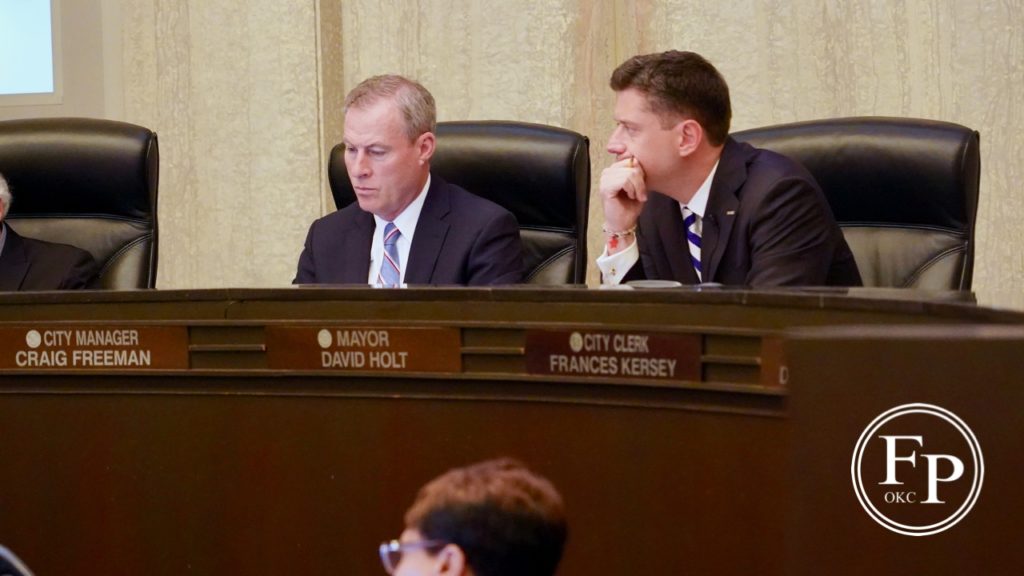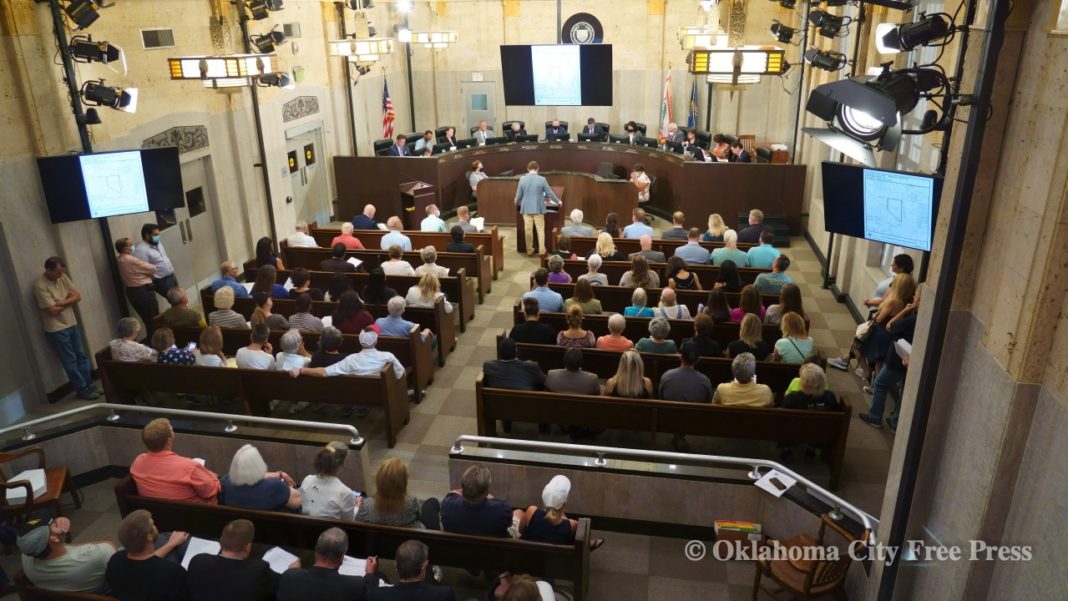Last Updated on February 15, 2022, 4:13 PM | Published: February 15, 2022
OKLAHOMA CITY (Free Press) — The City Council of Oklahoma City was treated to a final report by the Mayor’s Human Rights Commission Task Force Tuesday. Councilors also heard two brief presentations on MAPS 4 projects for mental health.
The Council went on to approve a new ordinance to protect pets from being kept outside in dangerous temperatures.
In sad news, the City said goodbye to longtime City Auditor Jim Williamson, who died last week. The Council also appointed an interim City Auditor to fill those very large shoes.

Marty Peercy reports Local government
Human Rights
After many residents of Oklahoma City called for a Human Rights Commission (HRC) during the restless summer of 2020, Mayor David Holt established a task force to develop a framework for such a commission.
That task force spent the past 18 months researching and planning, and gave a presentation on their work to the Council on Tuesday morning.
The City had an HRC for thirty years, but it was dissolved in 1996.
The task force worked with many members across a broad spectrum of political and cultural backgrounds from Oklahoma City to assure that a diversity of voices were at the table.
Maurianna Adams, one of the co-chairs of the task force, explained that the group split into four working groups.
The first group was tasked with case study research on existing HRCs in peer cities. The group researched 15 such Commissions in places like Tulsa, Austin, El Paso, and Albuquerque.
The group assessed data on topics such as forms of municipal government.
In Oklahoma City, for example, we have a council-manager, or “weak mayor” form of government where the council hires the city manager and then the manager does the hiring and firing of the rest of city staff except for two other positions we’ll describe below.
Tulsa, however, has a mayor-council or “strong mayor” form of government where the mayor has almost the same powers as OKC’s city manager. Other cities have hybrids. Those forms of government can inform how effective an HRC might be in different locations.

They also investigated the structure and processes of the HRCs in each of those cities in order to make recommendations for the future one in our community.
Other working groups’ foci included policy and legislation, the status of human rights in Oklahoma City, and finally a group to work on interagency working relationships.
The Council was told that educating constituents on the difference between “civil rights” and “human rights” is a lot of the work that is done by HRCs in other cities. Understanding what is a Human Rights violation goes a long way towards being able to address and find solutions for grievances and disputes.
The Human Rights Commission, according to the recommendations of the task force, should have 13 members. Those would include a member representing each ward, plus 5 at-large members. The membership should represent the diversity of Oklahoma City. At least one member should be an attorney or have a demonstrated knowledge of the law. The mayor would appoint the Chair and Vice-Chair of the Commission.
At an undetermined date in the future, the Council will take the recommendations of the task force under consideration before the Council will have to draft and agree to an ordinance re-establishing the Human Rights Commission.
MAPS 4
Though the two items were included on the consent docket and not scheduled for presentations to the Council, Ward 2 Councilman James Cooper asked for information on two Requests for Proposals (RFPs) for operating agreements related to MAPS 4.
The two items related to two major pieces of the MAPS 4 package for Mental Health.
First was Crisis Center #1, and second was for the Restoration Center.
Oklahoma City currently has two crisis centers. Federal law restricts mental health crisis centers to only 16 beds per. MAPS 4 includes funding for two additional centers.

The Restoration Center will also have some crisis beds, but will offer a bundle of other services. Described by some as a “crisis center on steroids,” Oklahoma City’s future Restoration Center plans closely mirror a successful model established in Bexar County, Texas (San Antonio, being the seat).
The Restoration Center will include facilities similar to a crisis center, but with several additions. The Center will have a sobering center, which can be an adjunct to the Public Inebriate Alternative at Linwood and Virginia, but with added social services.
There will also be a small extended-stay ward with medical oversight. Additionally, the center will have a detox unit, something desperately needed in Oklahoma City. Currently the only detox unit that can be accessed with no insurance in Oklahoma City is The Recovery Center (TRC), and their waitlist can become quite long.
It is unclear who might respond to the RFPs, but both crisis centers currently operating in Oklahoma City are under the purview of the Oklahoma Department of Mental Health & Substance Abuse Services (ODMHSAS, or simply ODMH).
The Council approved both RFPs.
Dog Ordinance
The Council was asked on Tuesday to consider and approve an ordinance concerning humane treatment of animals.
The ordinance specifically states that pets may not be kept outside when the temperature drops to 32 degrees or below.
During the extended freezing temperatures in February 2021, the Animal Welfare Department received a drastic spike in animal cruelty complaints.
The new dog-centered ordinance will allow animal welfare officers to take action if a pet is not brought inside or left with a heated structure to sleep in.
Ward 6 Councilperson JoBeth Hamon* of Ward 6 asked about breeds that enjoy cold temperatures. It would be remiss for the owner of a Husky, for example, to be cited for letting their dog enjoy being outside in the weather.
Officers are given some discretion about enforcement of animal codes. This is an example where perhaps a conversation with neighbors would be a better course of action that calling with an animal cruelty complaint.
The ordinance was approved unanimously, and was passed with an “emergency” clause, causing it to go into effect as of February 15, 2022.
City Auditor
Longtime public servant Jim Williamson, City Auditor of Oklahoma City since September 2008, died at home on February 3.

At Tuesday’s meeting, the City honored Williamson’s great service to the community over the many decades since he came to work for the City in 1988.
Mayor Holt called Williamson “a uniquely decent and hard-working public servant.”
Ward 5 Councilman David Greenwell commented as both a member of Council and as a fellow accountant, and referred to Williamson as a “star” in the accounting profession in Oklahoma.
In executive session following the open session of the Council meeting, the Council determined Williamson’s interim replacement.
Matt Weller, who has worked for the City for 21 years, and was Williamson’s Assistant Auditor, was unanimously chosen to stand in as interim City Auditor until such a time as a permanent replacement is named.
City Auditor is one of three positions hired by Council. Along with the Municipal Counselor and the City Manager, the positions are siloed so that there is accountability to be had for and from each position.
The City Council will meet again on March 1 at 8:30 a.m.
*Disclosure: Reporter Marty Peercy is the husband of Oklahoma City Council member JoBeth Hamon.
Columnist covering local government in Oklahoma City and Oklahoma County from May 2019 through June 2023.










